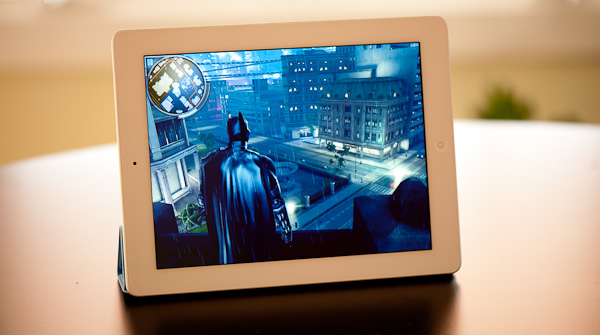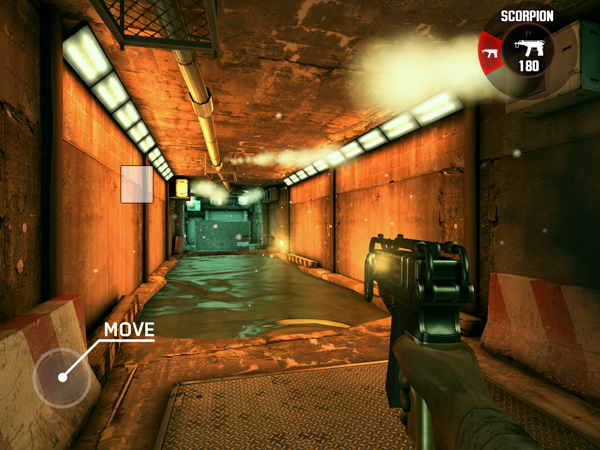iPad 4 (Late 2012) Review
by Anand Lal Shimpi on December 6, 2012 4:40 PM ESTPowerVR SGX 554MP4 and iPad Retina Display: A Balanced Platform
For app and game developers, modern day tablets are treated much like game consoles. Although the hardware does see yearly updates, developers aim for a fast experience on as many platforms as possible (within reason). This is particularly true for mobile game developers. I pointed this out in our 3rd gen iPad review as big reason why Apple's significant advantage in GPU performance doesn't actually translate into better frame rates in games compared to Tegra 3 based tablets. Instead what we see game developers doing a lot of is playing around with detail settings and resolutions in order to scale performance across various hardware platforms.
Like almost every first generation Retina Display equipped Apple product, the 3rd generation iPad was ahead of its time in some areas. Although Apple did a great job enabling Retina support in first party applications, the hardware driving the display wasn't necessarily up to snuff. The PowerVR SGX 543MP4 delivered twice the shader performance of the iPad 2's GPU, but it had to drive a display with 4x the pixel count. Apple needed a quadrupling of GPU performance (and potentially a similar increase in memory bandwidth) in order to allow the most demanding games to run at the iPad's native resolution.
As a compromise, some game developers rendered titles at an intermediate resolution and simply upscaled the frame buffer to the iPad's native display resolution. Epic's Infinity Blade 2 rendered internally at 1.4x the resolution of the iPad 2. Infinity Blade 2 relied on AA to make the lower resolution look better. In the case of Infinity Blade 2, the game played pretty similarly on the iPad 2 and 3 and looked better on the 3rd gen model, which delivered much of what Epic was hoping to accomplish there. The 3rd gen iPad looked better and played at a similar frame rate to its predecessor. It just didn't look as good as it could have.
Where the 3rd generation iPad fell short, the 4th generation model stepped up to the plate. By once again doubling shader performance over its predecessor, games that aren't bound elsewhere should finally be able to run at the iPad's native panel resolution. Games limited by memory bandwidth on the 3rd gen iPad may still run into issues as the new iPad doesn't bring much of an increase in memory bandwidth, the same goes for ROP and texturing limited scenarios as neither count increases over the A5X. Given the current trend in gaming evolution, investing in additional shader performance makes sense.
I've been playing a lot of games on the new iPad and generally found that they fall into one of three categories. In many cases, the developer simply delivers the same experience on the 3rd and 4th generation iPads. The internal rendering resolution remains the same, as do texture filtering and detail settings. In this (fairly common) scenario, a game may continue to render at a non-native resolution or even the native panel resolution depending on the performance demands of the title.
In some cases, the developer will use the added GPU horsepower to deliver added detail on the 4th generation iPad. Finally, there are some games where the developer will put the A6X to use in delivering a higher native resolution and/or AA mode. I put together some screenshots showing most of these scenarios. If you want the original, high-res sources for most of these shots I've zipped them up here.
Dead Trigger
Dead Trigger doesn't seem to change resolution at all between the 3rd and 4th generation iPads, but we do see an increase in filtering quality on the latest iPad. Performance remains unchanged between the two, but if you look at distant surfaces you'll see a distinct difference between the 3rd and 4th gen models. Whether or not you notice the increase in filtering quality in actual gameplay really depends on the user. Dead Trigger is fast paced enough where I didn't notice an appreciable difference between the iPad 3 and 4, but if you spend your time doing a lot of image quality analysis you'll likely appreciate the newer iPad.
For this test we're looking at the far end of the left wall, highlighted above. The crop below is enlarged - I also scaled up the iPad 2/mini output so you can easily compare the difference in detail. Click on the buttons below to switch the crop source:

With a faster GPU and more video memory, the iPad 3 looks better than the iPad 2/mini output. The iPad 4 enjoys an edge over the 3 in filtering quality.
Batman: The Dark Knight Rises
The latest Batman game shows a mild difference in image quality between the iPad 3 and 4, although a tangible increase in resolution compared to the iPad 2/mini. Like all of the games I'm showing here, there doesn't appear to be a huge performance difference between any of the tablets. The game developer simply varies image quality in order to keep performance as consistent as possible across iPad versions:
In this scene we're looking at a crop of the railing to the right of Batman, giving us a good look at differences in resolution as well as texture quality in the background.

This is a fairly common situation for a lot of the newer titles. There's a resolution advantage on the Retina iPads, with a slight image quality advantage for the iPad 4 over the 3rd gen model.
N.O.V.A. 3
Our next title is yet another first person shooter: Near Orbit Vanguard Alliance (N.O.V.A. 3). The NOVA games have done a good job of staying up to date with the latest Apple hardware, and the latest installment is no different. On the iPad 3, the game seems to run at the same resolution as on iPad 2/mini but with a fairly blurry upscale. With the 4th gen iPad however, the developer was able to render at a higher native resolution which significantly improves image quality.
For this test we're looking at the green sign in the middle of the scene. Lining up all of the screenshots identically proved to be pretty difficult, so you'll notice the crops below shift around a bit. The difference between platforms is dramatic enough however to get the point across. Once again I scaled the iPad 2/mini output to the same output resolution as the Retina iPads for easier comparison:

The improvement is substantial. The game looks a lot better on the iPad 4 than on the 3.
Infinity Blade 2
Epic's Infinity Blade 2 needs no introduction, it remains one of the best looking games on the app store. A consequence of really pushing the envelope on mobile hardware meant that Epic couldn't run the title at the iPad 3's native resolution upon its release, instead settling on an intermediate resolution. Infinity Blade 2 gives us a good showing of resolution progression from the iPad 2 all the way through the iPad 4.
Here we're looking at two separate crops: one from the roofline in the upper left hand corner and another looking at the top of the trees in along the left of the scene.

There's an obvious improvement here, but you can really see the added resolution at work in the extreme crop below.

I should add that how apparent the added resolution is really depends on how much you're looking for it. The difference between the iPad 2/mini and the iPad 3 is pretty significant, the move to the 4 is more incremental. Such is the nature of the beast. With annual hardware updates, many of the improvements you see going forward will be more incremental visually. As very few software vendors are interested in alienating a large install base of older iPads, they will hesitate to only support the absolute latest and greatest. It's the same issue we have in PC gaming. That's not to say that we won't see a Crysis equivalent appear in mobile to coincide with major hardware launches down the road, it just won't be the norm.
It's clear that the PowerVR SGX 554MP4 was the right match for the iPad's Retina Display. I highly doubt that Apple will stop increasing GPU performance going forward (Rogue cometh), but it finally does have a much better balanced SoC/display setup in the 4th generation iPad.















113 Comments
View All Comments
seapeople - Thursday, December 6, 2012 - link
How late would this review have had to be for you not to post that comment? In fact, I bet I you typed that comment up the moment you heard about the Ipad release, saved it in a Word document, and patiently waited to post it on the Ipad review that would obviously be coming.The fact that Anand is practically the last tech site on the planet to actually post a review of the new Ipad makes it extremely ironic that you use this action to insinuate that Apple is paying Anand off.
Oh well, it makes sense considering you can't even spell your own name right.
bplewis24 - Thursday, December 6, 2012 - link
It would be great to see the same image/resolution/detail comparisons that you did with the iPad iterations done with the iPad4 vs the Nexus 10 when it's ready.Zink - Thursday, December 6, 2012 - link
I agree. You don't need to do it with every new tablet but it is a good opportunity to do some really in depth head to head iOS vs Android on 10" tablets. We all know this iPad is basically like the last one. What is harder to understand and get data on is completely different products.daar - Thursday, December 6, 2012 - link
Would be nice to see in future reviews, can help get an idea of quality control and calibration, despite what Apple guarantees.Zink - Thursday, December 6, 2012 - link
"I no longer have a 45nm iPad 2 so forgive me for the incomplete dataset here (it's safe to say that the iPad 2 would at least equal the iPad 4 in battery life, if not exceed it)"That doesn't seem safe at all from the numbers you gave. The 45nm iPad 2 only hits 10.1 hours in the 4th gen battery rundown and it is going to take a big drop with the new test. The iPad 3 sees a 12% hit to battery life with the switch to the new smartphone web browsing battery life test. Both tests should use the same screen settings so the increased energy consumption is coming from the 45nm silicon and radio. Screen res and GPU energy consumption does not significant contribute to this decrease in runtime because it is a browser test. The iPad 4 is also able to improve on the newer test despite its high res. Crunching the numbers, the iPad 3 is using 600 mW more to run the new test. The iPad 2 uses a bit older tech inside so I would assume it needs a similar increase in energy, putting the 45nm iPad 2’s performance in the new battery life test at around 8.2 hours, possible worse.
Zink - Thursday, December 6, 2012 - link
I didn't see you had the iPad mini numbers there too. Even it sees a small hit on the new test so the iPad 3 GPU isn't what is hitting battery life the hardest. I would be surprised if the 45nm iPad 2 can do even 8.5 hours, assuming these battery rundown tests are fairly accurate.Velius - Friday, December 7, 2012 - link
Author states, "I've viewed the divide there as a line separating a computing device from an appliance. There's overlap in capabilities, but the overall experience tends to fall along those lines for me."This is a false meme that keeps getting propagated. Android is just as much of a walled garden as iOS, and I'm not talking about the App Store. I mean the functionality of the OS. Android is usually touted as having a lot more customizability than iOS, but this is an illusion. Sure, there are context-sensitive menus which are nice and all, but what you can and cannot do with them are a function of the app maker. It's like having a choice between Coke and Pepsi: you think you have a choice, but your options have been severely constrained. I've used both iOS and Android, the latter mainly to see what all the hype was about (as I am a Linux geek too, though prefer OS X for day-to-day), yet was astounded and shocked when I eventually tried it (on a SGS3 which I am now selling). Where was the full customizability? Where was this amazingly flexible system with tons and tons of features, bells, whistles, and doodads? It's just a copy of iOS! You have apps, and you run one at a time. That's just about it!
As in many other things, Apple leads, and the rest (Google, Samsung, et al.) follow. Everyone forgets that when the iPad was first rumored, speculations were rife with regards to the capabilities of its OS. Many in the tech world wanted a full-blown OS X experience on the iPad (the name wasn't revealed back then of course). Yet they got the "appliance" that iOS on the iPad is. And yet, instead of forging its own path by introducing a full-blown Linux system on a tablet or phone, Google chose to copy and reproduce the appliance aspect of iOS in Android. Only now is Canonical actually moving to port Ubuntu to phones/tablets, well it's really an Android/Ubuntu hybrid but you actually get a full desktop when you dock it. *That* I'm looking forward to.
So Android is just as much of an appliance as iOS, and iOS is just as much of a computing device as Android, if not more so. Yes, I'm talking about the superiority of the App Store - both in terms of quantity and quality. I have never seen a "killer app" in the Play Store that is also not present in the App Store (or with a better version). But ooh boy is it the case the other way around. There are some specialized scientific apps I use for research that just plain don't exist in Android. E.g., X-Windows Phase Plane (XPP) on the iPad:
https://itunes.apple.com/us/app/xpp/id433859546?mt...
Furthermore, of the apps that do get released for both Android and iOS, they generally work better in iOS. These considerations are in fact the main reason why I stick to Apple. The Nexus 10 et al. may be sexier in terms of hardware, but without good software, they are just not as functional.
The level of Android fanboyism on the Internet truly astounds me. The gall, to claim that Android is a "computing device", and iOS an "appliance"! Like it's Cray supercomputer vs. a toaster! How astoundingly ridiculous! Unfortunately, even though this meme is groundless, it will keep getting propagated, ironically mostly due to the tech/geek "cred" that Android fanboys confer onto themselves, failing to realize that they are not the only ones with such cred. Heck, iOS fanboys are also Linux users. (You're looking at one right here.) I wonder, though, how many Android fanboys are *really* computer savvy?
Comments like the ones the author made, and that inspired this post, make me wonder otherwise.
Velius - Friday, December 7, 2012 - link
Sorry about the vitriolic nature of that post. I'd erase and restart if I could.All I wanted to say is that modern tablets are pretty uniform in their capabilities and interfaces, so "computing device" vs "appliance" is a false distinction. Either they are all appliances, or all computing devices. (I see it as both.)
In any case, great review. I will echo what someone else said, that it's a real treat to have a review of the iPad 4 in particular especially as it's not that different than the iPad 3.
Keep up the good work. :)
DeciusStrabo - Friday, December 7, 2012 - link
What exactly are you missing in terms of customization of Android? I mean, you can go and switch out basically everything you want, Kernel, drivers, UI, functionality. You can add any software you want from any point you want (alternative App shops, your own developers, your own Linux/OS X machine). You can add your own codecs, drivers, functions. You can automate basically any part of the system if you so desire. So what are you missing exactly?Sufo - Friday, December 7, 2012 - link
I have to agree with DeciusStrabo. You really aren't getting the most out of your android device if you can't see the distinction between iOS and Android (this coming from someone who thinks both are pretty shitty). There are many many things you can do with Android _devices_ that you can't do with an iphone. Try flashing custom roms for example. You _can_ change pretty much every aspect of an Android device - assuming you can root it. Can you run full OS VMs in iOS? I don't know, but I know you can with Android. In terms of apps, mxplayer is better than any iOS video player, and poweramp is better than any audio player - I'd say these are pretty good wins (at the same time, iOS default audio player shits on the Android default). That's not to say I disagree with you - iOS certainly has the edge often (app-wise), but your conclusions about Android are unfair and not accurate.So yes, a stock manufacturer Android experience is much closer to iOS than many people would like to admit (though it *is still* more of a computing device for sure). However if you know how to leverage the most out of an Android device, then there are certain powerful things it can do than an iOS device simply can't. It's essentially trading killer apps for specific device use cases, which leaves the two pretty equal overall, but with a clear favourite for most people depending on what you want out of your device.